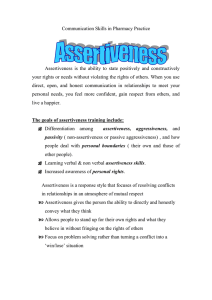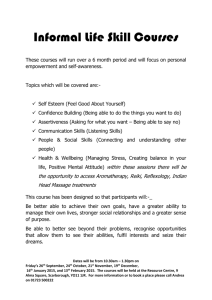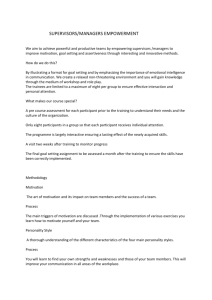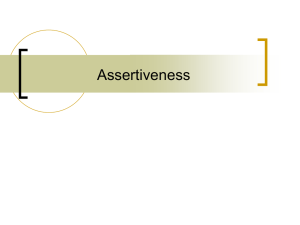Research Journal of Applied Sciences, Engineering and Technology 5(6): 1876-1882,... ISSN: 2040-7459; e-ISSN: 2040-7467
advertisement
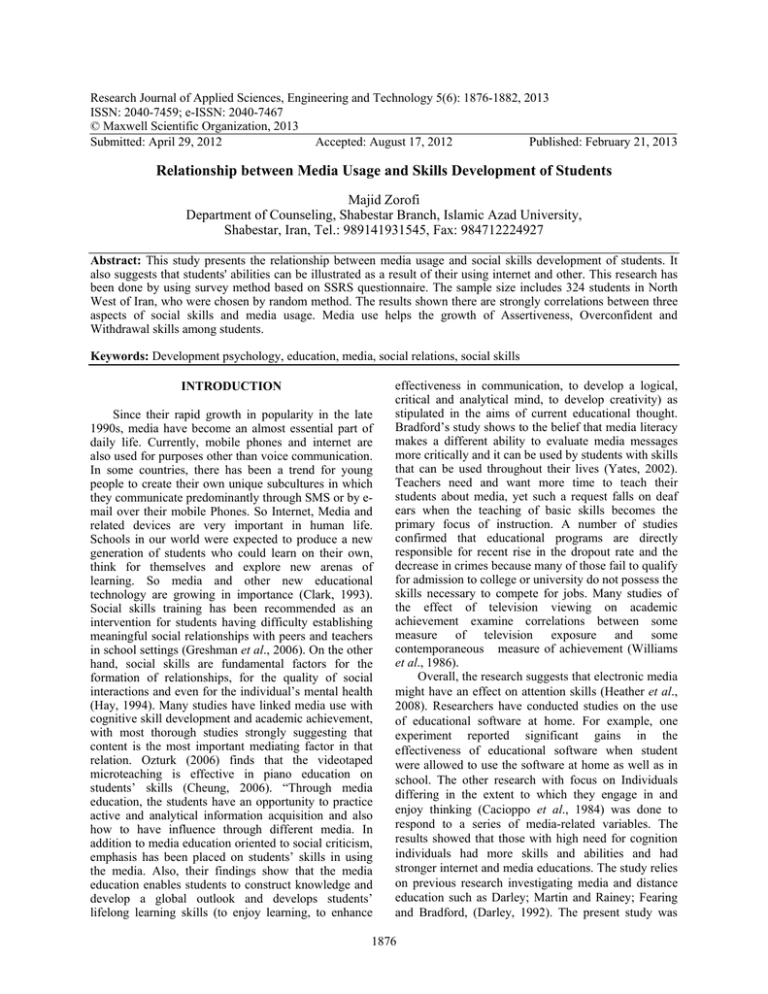
Research Journal of Applied Sciences, Engineering and Technology 5(6): 1876-1882, 2013 ISSN: 2040-7459; e-ISSN: 2040-7467 © Maxwell Scientific Organization, 2013 Submitted: April 29, 2012 Accepted: August 17, 2012 Published: February 21, 2013 Relationship between Media Usage and Skills Development of Students Majid Zorofi Department of Counseling, Shabestar Branch, Islamic Azad University, Shabestar, Iran, Tel.: 989141931545, Fax: 984712224927 Abstract: This study presents the relationship between media usage and social skills development of students. It also suggests that students' abilities can be illustrated as a result of their using internet and other. This research has been done by using survey method based on SSRS questionnaire. The sample size includes 324 students in North West of Iran, who were chosen by random method. The results shown there are strongly correlations between three aspects of social skills and media usage. Media use helps the growth of Assertiveness, Overconfident and Withdrawal skills among students. Keywords: Development psychology, education, media, social relations, social skills INTRODUCTION Since their rapid growth in popularity in the late 1990s, media have become an almost essential part of daily life. Currently, mobile phones and internet are also used for purposes other than voice communication. In some countries, there has been a trend for young people to create their own unique subcultures in which they communicate predominantly through SMS or by email over their mobile Phones. So Internet, Media and related devices are very important in human life. Schools in our world were expected to produce a new generation of students who could learn on their own, think for themselves and explore new arenas of learning. So media and other new educational technology are growing in importance (Clark, 1993). Social skills training has been recommended as an intervention for students having difficulty establishing meaningful social relationships with peers and teachers in school settings (Greshman et al., 2006). On the other hand, social skills are fundamental factors for the formation of relationships, for the quality of social interactions and even for the individual’s mental health (Hay, 1994). Many studies have linked media use with cognitive skill development and academic achievement, with most thorough studies strongly suggesting that content is the most important mediating factor in that relation. Ozturk (2006) finds that the videotaped microteaching is effective in piano education on students’ skills (Cheung, 2006). “Through media education, the students have an opportunity to practice active and analytical information acquisition and also how to have influence through different media. In addition to media education oriented to social criticism, emphasis has been placed on students’ skills in using the media. Also, their findings show that the media education enables students to construct knowledge and develop a global outlook and develops students’ lifelong learning skills (to enjoy learning, to enhance effectiveness in communication, to develop a logical, critical and analytical mind, to develop creativity) as stipulated in the aims of current educational thought. Bradford’s study shows to the belief that media literacy makes a different ability to evaluate media messages more critically and it can be used by students with skills that can be used throughout their lives (Yates, 2002). Teachers need and want more time to teach their students about media, yet such a request falls on deaf ears when the teaching of basic skills becomes the primary focus of instruction. A number of studies confirmed that educational programs are directly responsible for recent rise in the dropout rate and the decrease in crimes because many of those fail to qualify for admission to college or university do not possess the skills necessary to compete for jobs. Many studies of the effect of television viewing on academic achievement examine correlations between some measure of television exposure and some contemporaneous measure of achievement (Williams et al., 1986). Overall, the research suggests that electronic media might have an effect on attention skills (Heather et al., 2008). Researchers have conducted studies on the use of educational software at home. For example, one experiment reported significant gains in the effectiveness of educational software when student were allowed to use the software at home as well as in school. The other research with focus on Individuals differing in the extent to which they engage in and enjoy thinking (Cacioppo et al., 1984) was done to respond to a series of media-related variables. The results showed that those with high need for cognition individuals had more skills and abilities and had stronger internet and media educations. The study relies on previous research investigating media and distance education such as Darley; Martin and Rainey; Fearing and Bradford, (Darley, 1992). The present study was 1876 Res. J. Appl. Sci. Eng. Technol., 5(6): 1876-1882, 2013 designed to evaluate the impact of media usage by determining its effects on students’ social skills development. The mental health field is witnessing rapid scientific advancement of a new generation of learning such as social skills and media usage (Hayes et al., 1999). The basic debate has sensitized scholars to the important role that real people play in the reproduction of social life. So in micro level, media usage can help students to reproduce their interaction with others. For example as students practice questioning media and other information, they may begin a process of internal questioning every time they encounter media messages and this is helpful for increasing thinking skills. These attempts refine and develop the approach, synthesizing it with Giddens’ theory of structuration and Bourdieu's notion of habitués in order to understand to gain insight into the relationship between media, identity and power. Fligistein (2011) presents it by evidence to show that the mass media provide a key source of empowerment for the confined, offering a range of material from which they can create new identities or maintain pre-existing identities, exploring their inner selves, form subgroups based on collective fan ship and find autonomy and self-respect in all Circumstances (Jewkes, 2002). In the cognitive filed, (Gavriel, 1979; Salomon, 1979) argued that media can be analyzed in terms of their "cognitively relevant" capabilities, in terms of those characteristics that affect the ways in which individuals represent and process information. These capabilities relate to three aspects of each medium: its technology, symbol system(s) and processing capabilities. "Technology" refers to the physical, mechanical, or electronic capabilities that determine a medium's function (Nelson, 1976). We attempt to draw on social cognitive theory (Bandura, 1986), channel expansion theory (Carlson and Zmud, 1999) and media naturalness theory (Kock, 2005) and offer a theoretically based holistic view of how individual’s scan and abilities develop the capabilities to cope effectively with social structure forms. In this view, the media has a basic effect on students, cognition and their abilities. On the other hand, the concept of social skill as a one on personal development elements, originates in symbolic interaction (Mead, 1934; Goffman, 1974). Actors' conceptions of themselves are highly shaped by their interactions with others. When interacting, actors try to create a positive sense of self by engaging in producing meaning for themselves and others. Identities refer to sets of meanings that actors have that define who they are and what they want in a particular situation. According to self-efficacy theory, people develop confidence in technologies and behaviors through their experience of observing, using and evaluating them (Staples et al., 1999). These people with higher social skills could use the Internet in a better manner to extend their Relationships beyond their local networks (Wellman and Haythornthwaite, 2002). In other words, when individuals’ primary use of the internet is synchronous online social interaction, it becomes harder for them to control their internet (Caplan, 2005). In virtual settings, people expose themselves to technologies, putting them to various uses such as communication and collaboration .In this way, they have opportunities to develop their selfefficacy towards remote communication via ICT and working without being collocated. Namka (1997) talked about importance of social skills that these are positive abilities that help the child to interact with others in different situations in ways that are valued. Murphy (2005) found that underdeveloped social skills could lead to isolation, loneliness and frustration. Failure to develop adequate social skills can lead to negative feelings, self-doubt and low self-esteem. While contended that Social Skills are the foundation for getting along with others. The lack of Social Skills can lead to behavioral difficulties in school, delinquency, inattentiveness, peer rejection, emotional difficulties, bullying, difficulty in making friends, aggressiveness, problems in interpersonal relationships, poor selfconcept, academic failures, concentration difficulties, isolation from peers and depression. In this research we investigate the relationship between media usage and students' social skills developing also some aspects of social skills. We investigate this relation within students; social class, different cities, fields of studies, school population size (number of students) and sex. RESEARCH METHODOLOGY In this research, we used survey research method. We started by using a widely quoted review on social skill and media usage and then searched the database using the search term "social skill" combined with "student development" and "media usage". In case of doubt, the full study was retrieved and eligibility was discussed. In order to assess the improvement of students’ skills, a researcher made questionnaire was used to gather data on students’ social skill amount. The five aspects of student’s skills are: 1877 Appropriate: Behaviors with the development of positive act and thinking Inappropriate Assertiveness: Antisocial Behaviours or Acts and poor temper control Impulsive/Recalcitrant: A defense mechanism against feelings of inadequacy and low self-esteem. Overconfident: Confident to excess Withdrawal skills: Ability to retreat from interpersonal contact and social involvement Res. J. Appl. Sci. Eng. Technol., 5(6): 1876-1882, 2013 The questionnaire included 62 questions in all dimensions. Specifically, this scale measures the following sub-skills: Appropriate skills Assertiveness skills Impulsive skills Overconfident skills Withdrawal skills Based on the measurements, total scores are calculated and treated as indices of the ability to practically use information. The survey contained 18 questions regarding the appropriate skills, 12 questions regarding the assertiveness skills, 13 questions regarding the Impulsive skills, 9 questions regarding the overconfident skills, respectively and 10 questions regarding the Withdrawal skills, respectively. For each question, the subjects were asked to answer by using a 5-point scale. The validity and reliability of questionnaire are performed by using various methods. We examined the content validity by using reviewer’s evaluation of scale elements then factor analysis used for classifying social skills elements in theoretical categories after data collection. We obtained the high validity. Additional questionnaire included 11 questions about each of the different type of using media. This section was containing five-point LIKERT scale as well as a number of usage questions. These included media (TV, mobile and internet usage time per day) use. The media usage Total score was obtained by adding the times scores. Other section of questionnaire' regarding the measuring other variables (sex, school size, field of study, media type). Data collection was done through four months by interviewers at Azerbaijan Province high schools, was conducted in spring 2010 and served as the basis of this research study. Data obtained from 324 (164 males and 160 females) junior high school students who participated in the surveys was later analyzed. We used classified sampling method; the students have ready access to the classroom and as such have been the subjects of many prior research studies. Data were analyzed using descriptive and inferential statistical analysis. Frequencies tables and description statistics used to describe each variable. The inferential statistical analysis was conducted to address the research questions and examine the relationships among the variables. Analyses using the Pearson correlation coefficient model were conducted in order to examine the relationship between the social skill and the use of media such as the Internet and ZR test were used for comparing correlations between groups such as sex and school population size. A hazard ratio is the ratio of instantaneous probability of the outcome event in the student skills (male and female) compared with that in the groups and can be considered a relative risk. For simplicity, Factor analysis was used to determine dimension of students’ skills manipulation check scales. We conducted reliability tests, correlation tests and compared analysis to analyze the data collected by using SPSS software. To analyze the hypotheses, the scores of the constructs (media usage) were computed by adding the corresponding items scores and we obtained total score for media usage variable. Further scale development and testing was necessary to identify valid and reliable scales for media usage measurements. The score of each aspect of skills was normally distributed. We investigated the effect of media usage on students’ skills by performing Pearson correlation coefficient. Although these scales were designed for students, they had acceptable reliability (chronbakh's alpha equal to 0.73). RESULTS (61.5%) of the total respondents were mobile phone users. 44.8% of whom (27% of the total respondents) were PC e-mail users. Forty five percent of the respondents accessed the Internet, whereas 21% of the Internet users did not have PC but they are used only mobile phones to access the Internet. All of the respondents accessed the TV and more time (min 2 h/day) watch TV. Table 1 shows mean values and standard deviations of the students, social skill, its 5 sub-skills and the amount of media use. As seen on Table 2, we found a strongly correlation between media usage and total score of social skills. Media usage was positively correlated with Social skills scale score (r = 0.25). Also three dimensions of social skills (Assertiveness, Overconfident and Withdrawal) were meaningful correlated with media usage (total score). These findings led us to conclude that whenever media usage increases, then students’ skills increase as well. Also it was found that the media usage was positively correlated with Assertiveness skills (r = 0.40) and Withdrawal skills (r = 0.19) more than other aspects of social skills. Table 2 shows other dimensions of students’ social skills were less correlated with media usage, in comparison with the Assertiveness, Overconfident and Withdrawal skills. Table 1: The means and S.D. of the social skills, its sub-skills and the amounts of media use Skills Range Mean Percent S.D. Total score 62-310 241.13 77.78 21.2 Appropriate skills 18-90 71.26 79.17 8.6 Assertiveness skills 12-60 51.49 85.81 5.6 Impulsive skills 13-65 51.18 78.73 6.2 Overconfident skills 9-45 29.62 65.82 5.2 Withdrawal skills 10-50 37.58 75.16 5.7 Media usage score 11-55 36.87 67.03 5.9 1878 Res. J. Appl. Sci. Eng. Technol., 5(6): 1876-1882, 2013 Table 2: Correlation between students’ social skills, its 5 sub-skills and media usage Media use total score Internet use --------------------------------- --------------------------------Social skill dimensions r Sig. r Sig. Appropriate skills 0.09 0.120 0.09 0.120 Assertiveness skills 0.40** 0.000 0.45** 0.000 Impulsive skills 0.06 0.282 0.07 0.185 Overconfident 0.21** 0.000 0.31** 0.000 Withdrawal skills 0.19** 0.001 0.09 0.120 Total score 0.25** 0.000 0.28** 0.000 TV use ---------------------------------r Sig. 0.09 0.120 0.26** 0.000 0.09 0.120 0.21** 0.030 0.24** 0.000 0.23** 0.001 Mobile use ---------------------------r Sig. 0.09 0.120 0.48** 0.000 0.02 0.670 0.08 0.130 0.24** 0.000 0.24** 0.001 Table 3: Comparing correlation between assertiveness skills with media usage within school population (<200 and high) School population ----------------------------------------------------------------------------------------------<200 student 200 and more -----------------------------------------------------------------------------------------zr r zr r Correlation coefficient Z Assertiveness skills with media usage 0.56 0.49 0.32 0.31 2.18 Table 4: Comparing correlation between overconfident skills with media usage within school population (<200 and high) School population --------------------------------------------------------------------------------------------<200 student 200 and more ---------------------------------------------------------------------------------------zr r zr r Correlation coefficient Overconfident skills with media usage 0.32 0.31 0.11 0.11 All of three media usage sub scale was strongly correlated with Assertiveness skills. But mobile use scale was strongest correlated than other media sub scales. This is meaning that mobile use can developed Assertiveness skills more than other media such as internet. But internet use scale was strongest correlated than other media sub scales with Overconfident skills. This is meaning that internet use can developed overconfident skills more than other media such as mobile. The correlation between media usage and academic skills supports what Murray (2001) found which refers to the fact that there are many reasons why a prospective student would choose to take online, distance and media courses. With regard to time spent on internet use, the amount of use measured indicated significant positive effects on The Assertiveness skills and over confident skills. However, the amount of internet use indicated positive effects on the total score for the social skills. Also, With regard to time spent on TV use, the amount of use measured indicated significant positive effects on the Assertiveness skills, withdrawal and over confident skills. But the correlation between TV use times with Assertiveness skills is higher than other tree correlations. So we see that the TV use can develop the Assertiveness skills among high school students. However, the amount of TV use indicated positive effects on the total score for the social skills. With regard to time spent on mobile use, the amount of use measured indicated significant positive effects on the Assertiveness skills and Withdrawal skills. AS seen on the TV, the use of mobile can develop the Assertiveness skills more than other aspects of the skills. Also the amount of TV use indicated positive effects on the total score for the social skills. Z 1.9 With regard to media usage scale, the amount of use measured indicated significant positive effects on the Assertiveness skills, withdrawal and over confident skills. Also we found meaningful correlation between media use with social skills total score. By looking at the Table 2, we can see that: Overconfident skill scale was strongly correlated with Internet use more than other media. Also Assertiveness skill scale was strongly correlated with Mobile Internet use more than other media and Withdrawal skill was strongly correlated with TV and mobile Internet use more than other media. The correlation between media usage scale was correlated with social skills aspects are below: Assertiveness skills (0.40), overconfident skill (0.21) and withdrawal skill, (0.19) and total score of social skills (0.25) respectively. So we obtain that media usage Can be effective in developing students' Assertiveness skills twice withdrawal skill. The correlation between social skills scale was correlated with media usage sub aspects are below: internet usage (0.28), mobile usage (0.24) and TV use (0.23), respectively. This finding illustrated those students social skill primarily influenced by internet usage more than TV and mobile. However there is less difference between social skills correlations with media usage three sub scales. Correlation between the use of media and social skills among two groups of boys and girls is no significant difference. But it was found that there is significance difference between students’ social skills with media usage within different schools. Assertiveness and Overconfident Relationships with media use in schools with a population of less than 200 was more than the rest (Table 3 and 4). 1879 Res. J. Appl. Sci. Eng. Technol., 5(6): 1876-1882, 2013 Fig. 1: Comparing correlations between assertiveness and withdrawal skills with media usage within fields of study Also it was found that the correlation between two aspects of students’ social skills (Assertiveness and Withdrawal) with media usage is very different within students’ field study, which means to have the different correlation coefficients within fields of study (Fig. 1). For example, Correlation between media usage and Withdrawal skill within mathematics and humanities field of study, are much higher than other fields. But within Sciences filed, we see lowest rate of correlation between withdrawal skills and media usage. Unlike, correlation between assertiveness and media usage within Sciences field of study, is highest than other fields especially humanities and math. There were no significant differences between mathematics and Humanities Students' field of study. CONCLUSION After completing this study, it seems that the state of media usage in these schools is better than might be inferred from past researches that has focused on the challenges them and have a pathological approach about media usage efforts. But this study cleared that the use of media can helpful and might be better than some other traditional learning activities. Overall, the relationships predicted about the effective of media usage on students’ social skills within the framework of the Elaboration correlation Model were supported. According to the statistical analysis, it is found that media usage creates growth, develops and helps to students’ social skills and abilities in order achieve social success. This finding is according to Clark (1993) and Namka (1997) that believes about importance of media and social skills. According to many studies such as Heather et al. (2008). Anderson, data analysis shown that there was significant correlation between media usage and students’ social skills (Fligstein, 2001). Also media usage has different correlations with aspects of social skills. The correlation between media usage and overconfident is according to Cheung (2006) about increasing criticism abilities by using media. The study found a significantly positive association between the type of social skills and the relative Preference for various media (mobile, TV and internet). The study also indicated that a higher level of media usage (internet) promotes the social skills (Assertiveness skills), but Impulsive skills are not significantly associated with the use of media. Also these results suggest that mobile is useful for those who have limited Assertiveness skills. The results indicate that the schools with less number of students have a good context for develops students skill by using media than highly populous schools school. This finding indicates that the amount of internet use by students plays a great role in his/ her skills development. It was also found that the correlation between student's social skills and media usage were not correlated with the gender, where among the female students, not higher or lowest relations between social skills with using TV, mobile and Internet than their male students. In this perspective, both boys and girls students are similar, because the relationship between media use and skills didn't differ between boys and girls groups. This finding could be explained that the girls and boys are equal for developing skills by using media. This finding not supports what Murphrey and Dooley found that female had the highest distance education value scores (Dooley and Murphrey, 2000). As found in many 1880 Res. J. Appl. Sci. Eng. Technol., 5(6): 1876-1882, 2013 studies, such as James (2002) human skills are always influenced by the lack of knowledge of the nature and advantage of media usage. Therefore, the institutions such as family and schools could introduce optimal media usage services to all child and adolescent, especially for students prior to starting the service to ensure more involvement into education activities for skills achievement. It seems reasonable to conclude that the media usage is helpful and necessary that reinforces students’ skills development. Our finding about field study indicates that students’ studying field study play a significance role in their skills learning and so personality development by using media. This finding is compatible with what Gary found regarding the consequence of computer and internet skills and need for using such technologies (Gary, 1997). Therefore, it is very important that other institutions such as school, family and cultural institutions could also initiate professional development process directed toward media usage by providing public with awareness, scientific programs and tutorial for optimal media usage, prior implementing the system as it was found in this study, the availability of a suitable infrastructure for media learning programs is a significant factor for developing skills. This finding is in agreement with Murphy (2005) ideas about importance of skills learning. Therefore, providing the students with sufficient social skills and reliable facilities will be a significant factor for successful implementation of child development by controlling any factors and condition that be able to decrease their abilities and can as prevent of their development too. Review of such study results implies that the effect of Internet use outside classes on the students' social skill is not clear and it is believed that more research is necessary. Recent study findings point to significant trend that needs to be taken up in further studies. It needs to be investigated if the presence of the same set of variables, such as media content, regular contact with groups and friends, learning style outside the school is related with it. It would also be interesting to study whether students’ skills are investigated in other areas and time by controlling variables such as socialization process, educational programs and social group relations due to the influence of other variables. REFERENCES Bandura, A., 1986. Social Foundations of Thought Action: Asocial Cognitive Theory. Prentice-Hall, Engle Wood, NJ, USA. Cacioppo, R., E. Petty and C.F. Kao, 1984. The efficient assessment of need for cognition. J. Person. Assess., 48(3): 306-307. Caplan, S.E., 2005. A social skill account of problematic internet use. J. Commun., 55(4): 721-736. Carlson, J.R. and R.W. Zmud, 1999. Channel expansion theory and the experimental nature of media richness perceptions. Acad. Manag. J., 42: 153-170. Cheung, C.K., 2006. The implementation of media education in Hong Kong secondary curriculum. The 10th APEID International Conference Faculty of Education, University of Hong Kong, Bangkok. Clark, T., 1993. Attitudes of higher education faculty toward distance education. Am. J. Dist. Educ., 7(2). Darley, W.K., 1992. The role of need for cognition in media evaluation and usage: Innovations in planning and applied research. J. Prom. Manag., 1(3). Dooley, K. and T. Murphrey, 2000. How the Perspectives of Administrators, Faculty and Support Units Impact the Rate of Distance Education Adoption. Retrieved from: http://www. westga.edu/~distance/ojdla/winter 4/dooley34html, (Accessed on: October 26, 2003). Fligstein, N., 2001. Social Skill and the Theory of Fields. University of California Berkeley, Ca. 94720, USA. Gary, S., 1997. Training Teachers, Faculty Members and Staff. In: Khan, B.H. (Ed.), Web Based Instruction. Educational Technology Publications, Englewood Cliffs, NJ. Gavriel, S., 1979. Interaction of Media, Cognition and Learning. Jossey Bass, San Francisco. Goffman, E., 1974. Frame Analysis. Harvard University Press, Cambridge, Ma. Greshman, F.M., M.B. Van and C.R. Cook, 2006. Social skills training for teaching replacement behaviors: Remediating acquisition deficits in atrisk students. Behav. Disord., 31(4): 363-377. Hay, D.F., 1994. Presocial development. J. Child Psychol. Psychiatry, 35(1): 29-71. Hayes, S.C., K.D. Strosahl and K.G. Wilson, 1999. Acceptance and Commitment Therapy: An Experiential Approach to Behavior Change. Guilford Press, New York. Heather, L.K., A.W. Ellen and R.A. Daniel, 2008. Media and young children’s learning. Future Child, 18(1). James, B.T., 2002. When the Brain Can't Hear: Unraveling the Mystery of Auditory Processing Disorder. Simon and Schuster, New York, pp: 368, ISBN: 0743436431. Jewkes, Y., 2002. The use of media in constructing identities in the masculine environment of Men's prisons. Euro. J. Commun., 17(2): 205-225. Kock, N., 2005. Media richness or media naturalness? The evolution of our biological communication apparatus and its influence on our behaviour toward e-communication tools. IEEE Trans. Profess. Commun., 48(2): 117-130. Mead, G.H., 1934. Mind, Self and Society . University of Chicago Press, Chicago, IL. 1881 Res. J. Appl. Sci. Eng. Technol., 5(6): 1876-1882, 2013 Murphy, P., 2005. Social Skills Training can Positively Impact Your Life. Retrieved from: https://docs.google.com/viewer?a=v&q=cache:tpxa UsSGF1cJ:pu.edu.pk/images/journal/ier/PDF-FIL ES/5-Social % 2520 Skills % 2520 among % 2520 Children % 2520 at % 2520 Elementary % 2520 Level.pdf + Murphy,+P.,+2005.+ Social + Skills+Training+can + Positively+Impact + Your + Life & hl = en&gl, (Accessed on: October 31, 2006). Namka, L., 1997. Social skills and Positive Mental Health. Retrieved from: http://members.aol. com/AngriesOut/ teach4.htm, (Accessed on: August 14, 2006). Nelson, G., 1976. Languages of Art. Hackett, Indianapolis, pp: 231. Ozturk, B., 2006. The Piano video camera, e-training of the method of micro-ö-ö-school student kayd2na dayal2 baÕar2s2na effect. Ph.D. Thesis, Educational Science Gazi University, Ankara, Turkey., Salomon, G., 1979. Interaction of Media, Cognition, and Learning. Jossey-Bass, San Francisco. Staples, D.S., J.S. Hull and C.A. Higgins, 1999. A selfefficacy theory explanation for the management of remote workers in virtual organizations. Organ. Sci., 10: 758-776. Wellman, B. and C. Haythornthwaite, 2002. The Internet in Everyday Life. Blackwell Publishing, Malden, MA, pp: 372-403. Williams, P.A., E.H. Haertel, G.D. Haertel and H.J. Walberg, 1986. The impact of leisure-time television on school learning: A research synthesis. Am. Educ. Res. J., 19.78: 373-380. Yates, B.L., 2002. Media education's present and future: A survey of teachers. Stud. Med. Liter. Educ., 2(3). 1882
